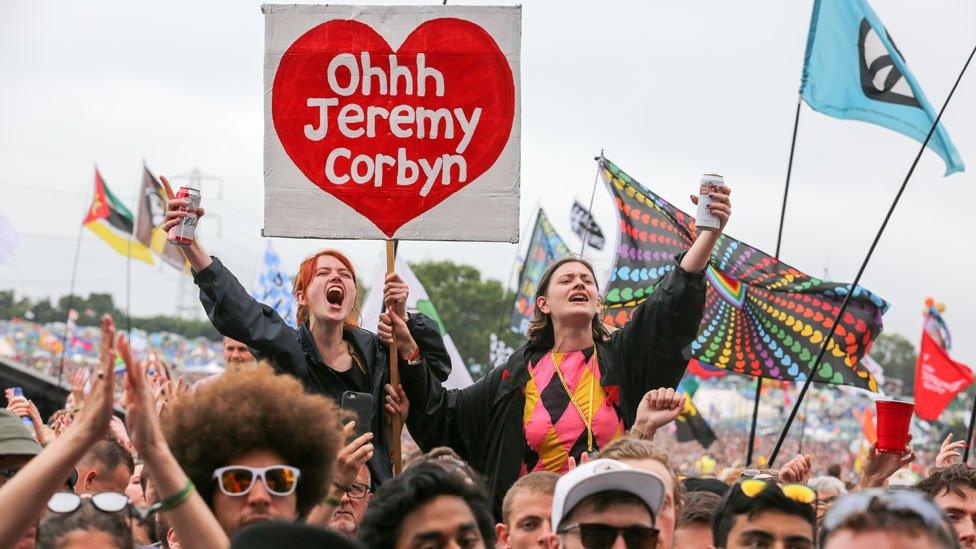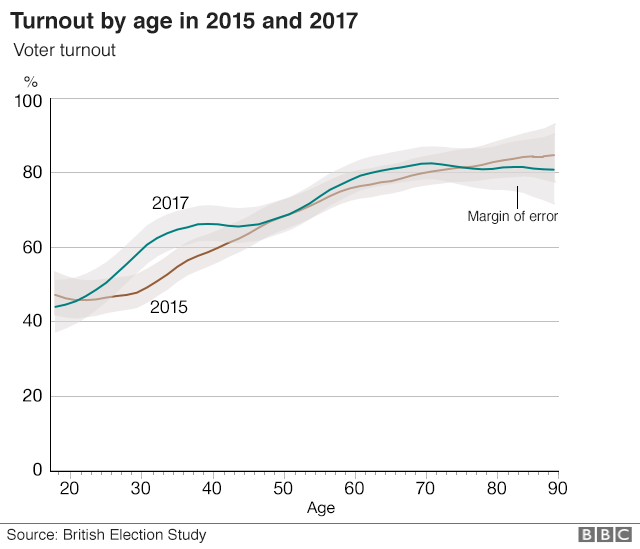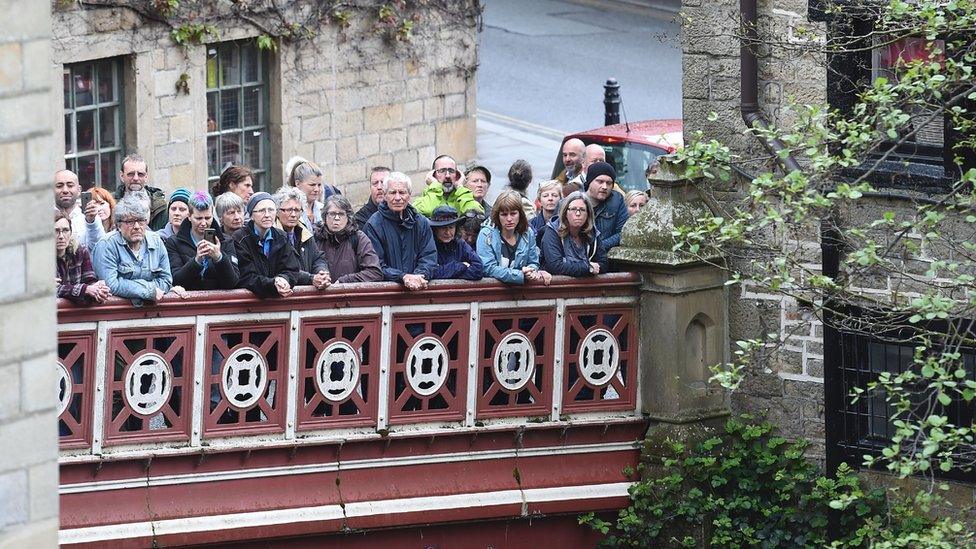The myth of the 2017 'youthquake' election
- Published
- comments

A surge in youth turnout has often been cited as the reason for Labour's unexpectedly strong performance in the 2017 election. The trouble is, it seems there was no such "youthquake", write members of the British Election Study team.
After the surprise of the Conservatives losing their majority in the June 2017 general election, people started looking for an explanation.
One theory quickly came to prominence: Jeremy Corbyn had enthused previously disengaged young voters, who turned out in droves to vote Labour.
Certainly, Mr Corbyn appears to be popular with young people - he is often pictured surrounded by young supporters and that summer's Glastonbury Festival echoed to chants of "Oh, Jeremy Corbyn".
Opinion polls lent weight to the idea - one polling organisation suggested that turnout among 18 to 24-year-olds went up by as much as 16 percentage points, another suggested an increase of 12 points.
The youth mobilisation explanation came to be seen as a fact and the Oxford English Dictionary even declared "youthquake" - a political awakening among millennial voters - its word of the year.

But we now know there was no surge in youth turnout.
Since 1964, the gold standard measure of electoral behaviour in Britain has been the British Election Study's face-to-face survey.
Newly released results using this data show that there was very little change in turnout by age group, external between the 2015 and 2017 elections.
Younger voters were still much less likely to vote, older voters much more so.
The graph below shows the predicted probability of turning out in the election, by age.
Among the youngest voters, the margin of error means that we cannot rule out a small increase - or decrease - in 2017.

In both years, turnout among the youngest voters was between 40% and 50%.
That there was no surge in youth turnout should probably not be as surprising as it is.
Everything we know about turnout suggests that voting is "sticky" - most people who vote in one election will go on to vote at subsequent elections, and most people who abstain will continue to do so.
We also know that older people are more likely to vote than young people - something that has always been the case in Britain and other countries.
Overall turnout did go up in 2017, but only by 2.5 percentage points.
All of this suggests that large, sudden, and unexpected shifts in the age-turnout relationship are very unlikely.
The idea that there was a surge in youth turnout may reflect a belief that politicians achieve success because of what they set out to do.
In this case, increasing youth turnout was part of Mr Corbyn's political strategy.
As Labour did unexpectedly well, it was not unreasonable to form the view that the strategy paid off.
In a sense it did: Labour was more popular among young people than old people in 2017 and its share of the youth vote did increase.

But winning the support of more of the young people who vote is not the same as a surge in youth turnout.
It is also worth pointing out that in 2017 Labour's popularity increased among all ages, except for those over 70.
Among older age groups there was also a big shift in the probability of voting Conservative, as many UKIP voters switched following the Brexit referendum.
Another reason the idea of a surge in youth turnout took hold is that the constituency-level data appeared to support the claim.
However, drawing conclusions about the behaviour of individuals from this bigger picture is risky.

We can see this at work with the change in turnout between 2015 and 2017.
Turnout did go up in constituencies with more young voters.
For every percentage point increase in 18 to 29-year-olds living in a constituency, turnout went up by 0.1 percentage points compared with 2015.
However, this relationship is not as straightforward as it appears.
For every percentage point increase in nought to four-year-olds living in a constituency, turnout went up by 0.9 percentage points.
Few people, it is probably safe to say, think that turnout went up in 2017 because of a sudden surge in the number of toddlers voting.
What this relationship is showing, of course, is not that turnout went up among toddlers, but that turnout went up in the sorts of places with lots of toddlers.
The same is true of the relationship between the number of young adults and turnout.
There was a slight increase in turnout in the sorts of places with lots of young adults.
But it was not necessarily those young adults doing the extra turning out.

Older people were still more likely to vote than younger people
So how did people get it so wrong?
One reason is that measuring turnout in surveys is tricky - and people who don't vote also tend to be more reluctant to take part in them.
This means we can end up with too many voters in surveys, which become insufficiently representative of the general population as a result.
Second, some people will tell you they voted when they actually didn't.
Third, many surveys are conducted over the phone or internet, again attracting more people who are likely to vote.
The British Election Study face-to-face survey is designed to be as representative of the country as possible - including people who didn't vote in the election.
People are chosen randomly from thousands of addresses across the country and doors are knocked until as many of those selected as possible participate.
And people's survey answers about turnout are verified by the checks against the marked electoral register.
Of course, the BES face-to-face survey isn't perfect, but the results are as close to the truth about who turned out to vote as we can get.

About this piece
This analysis piece was commissioned by the BBC from experts working for an outside organisation.
Dr Chris Prosser, Prof Ed Fieldhouse, Prof Jane Green, Dr Jon Mellon (all University of Manchester), and Prof Geoff Evans (University of Oxford) are members of the British Election Study, external Team.
The British Election Study has carried out studies of voter behaviour at every election for the past 50 years and is funded by the Economic and Social Research Council.
The 2017 BES face-to-face surveyed 2,194 people, of which 1,475 had their votes validated. The 2015 BES face-to-face surveyed 2,987 people and validated 1,974.

Charts produced by Tom Calver
Edited by Duncan Walker